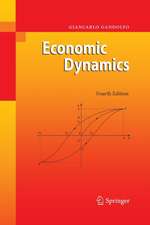Time-To-Build: Interrelated Investment and Labour Demand Modelling With Applications to Six OECD Countries: Lecture Notes in Economics and Mathematical Systems, cartea 420
Autor Marga Peetersen Limba Engleză Paperback – 17 feb 1995
Din seria Lecture Notes in Economics and Mathematical Systems
-
 Preț: 360.02 lei
Preț: 360.02 lei -
 Preț: 383.93 lei
Preț: 383.93 lei -
 Preț: 384.09 lei
Preț: 384.09 lei -
 Preț: 380.07 lei
Preț: 380.07 lei -
 Preț: 446.26 lei
Preț: 446.26 lei -
 Preț: 497.37 lei
Preț: 497.37 lei -
 Preț: 380.84 lei
Preț: 380.84 lei -
 Preț: 384.86 lei
Preț: 384.86 lei -
 Preț: 378.34 lei
Preț: 378.34 lei -
 Preț: 399.67 lei
Preț: 399.67 lei - 20%
 Preț: 360.93 lei
Preț: 360.93 lei - 15%
 Preț: 643.16 lei
Preț: 643.16 lei -
 Preț: 379.09 lei
Preț: 379.09 lei -
 Preț: 404.74 lei
Preț: 404.74 lei -
 Preț: 385.62 lei
Preț: 385.62 lei - 15%
 Preț: 644.49 lei
Preț: 644.49 lei -
 Preț: 379.09 lei
Preț: 379.09 lei -
 Preț: 345.50 lei
Preț: 345.50 lei -
 Preț: 425.80 lei
Preț: 425.80 lei -
 Preț: 378.34 lei
Preț: 378.34 lei - 18%
 Preț: 775.65 lei
Preț: 775.65 lei -
 Preț: 392.60 lei
Preț: 392.60 lei -
 Preț: 401.61 lei
Preț: 401.61 lei - 15%
 Preț: 646.43 lei
Preț: 646.43 lei -
 Preț: 382.18 lei
Preț: 382.18 lei -
 Preț: 378.34 lei
Preț: 378.34 lei - 15%
 Preț: 637.59 lei
Preț: 637.59 lei - 15%
 Preț: 647.27 lei
Preț: 647.27 lei -
 Preț: 377.73 lei
Preț: 377.73 lei -
 Preț: 447.84 lei
Preț: 447.84 lei - 15%
 Preț: 644.49 lei
Preț: 644.49 lei -
 Preț: 386.00 lei
Preț: 386.00 lei - 15%
 Preț: 654.43 lei
Preț: 654.43 lei -
 Preț: 415.02 lei
Preț: 415.02 lei -
 Preț: 411.54 lei
Preț: 411.54 lei -
 Preț: 398.92 lei
Preț: 398.92 lei -
 Preț: 398.92 lei
Preț: 398.92 lei -
 Preț: 392.75 lei
Preț: 392.75 lei - 15%
 Preț: 635.47 lei
Preț: 635.47 lei - 20%
 Preț: 653.56 lei
Preț: 653.56 lei -
 Preț: 379.86 lei
Preț: 379.86 lei -
 Preț: 495.46 lei
Preț: 495.46 lei -
 Preț: 447.99 lei
Preț: 447.99 lei -
 Preț: 378.71 lei
Preț: 378.71 lei - 15%
 Preț: 637.13 lei
Preț: 637.13 lei -
 Preț: 385.84 lei
Preț: 385.84 lei -
 Preț: 378.54 lei
Preț: 378.54 lei - 15%
 Preț: 666.55 lei
Preț: 666.55 lei -
 Preț: 380.07 lei
Preț: 380.07 lei
Preț: 383.71 lei
Nou
Puncte Express: 576
Preț estimativ în valută:
73.43€ • 77.01$ • 61.12£
73.43€ • 77.01$ • 61.12£
Carte tipărită la comandă
Livrare economică 01-15 aprilie
Preluare comenzi: 021 569.72.76
Specificații
ISBN-13: 9783540588092
ISBN-10: 3540588094
Pagini: 220
Ilustrații: IX, 204 p.
Dimensiuni: 155 x 235 x 12 mm
Greutate: 0.31 kg
Ediția:Softcover reprint of the original 1st ed. 1995
Editura: Springer Berlin, Heidelberg
Colecția Springer
Seria Lecture Notes in Economics and Mathematical Systems
Locul publicării:Berlin, Heidelberg, Germany
ISBN-10: 3540588094
Pagini: 220
Ilustrații: IX, 204 p.
Dimensiuni: 155 x 235 x 12 mm
Greutate: 0.31 kg
Ediția:Softcover reprint of the original 1st ed. 1995
Editura: Springer Berlin, Heidelberg
Colecția Springer
Seria Lecture Notes in Economics and Mathematical Systems
Locul publicării:Berlin, Heidelberg, Germany
Public țintă
ResearchCuprins
0 Overview.- 0.1 Introduction.- 0.2 Main research aims.- 0.3 Outline.- 1 Physical Capital Stock Investments and Labour Demand, Theoretical background on dynamic modelling.- 1.1 Introduction.- 1.2 Entrepreneurial behaviour.- 1.3 Entrepreneurial behaviour under neoclassical assumptions.- 1.4 Dynamics and the literature.- 1.5 Short summary and extensions.- 1.A Dynamics and interrelation in structures, equipment and labour in six OECD countries.- 2 Investment Gestation Lags, Construction lags, delivery lags and capital stock accumulation.- 2.1 Introduction.- 2.2 Construction lags.- 2.3 Time-to-build specification.- 2.4 The difference between construction and delivery lags.- 2.5 Statistical evidence on lead times.- 2.6 The calculation of physical capital stock series.- 2.7 Summary and conclusions.- 3 A Closed form Solution for a Model with Time-to-Build and Adjustment Costs, An application to the United States and Dutch manufacturing industry.- 3.1 Introduction.- 3.2 The model.- 3.3 Three univariate models for structures.- 3.4 The closed form solution of the trivariate model.- 3.5 Summary of the theoretical part and estimation aims.- 3.6 The estimation results.- 3.7 Summary and conclusions.- Appendices.- 3.A Solving the Euler equations of the multivariate model for the rational expectations.- 3.B Stationarity tests.- 4 Persistence, Asymmetries and Interrelation in Manufacturing Structures, Equipment and Labour Demand, An application to six OECD countries.- 4.1 Introduction.- 4.2 Descriptive statistics.- 4.3 A neoclassical factor demand model.- 4.4 Empirical analyses.- 4.5 Summary and conclusions.- 4.A Factor prices exogeneity, monopolistic competition or price influencing.- 5 Interrelations in Physical Capital Stock, Labour and Inventory Investments, An application to Frenchindustrial sectors.- 5.1 Introduction.- 5.2 Volatility and multi-cointegration.- 5.3 Two structural models with inventories.- 5.4 Empirical results.- 5.5 Conclusions.- 6 Summary, Conclusions and Shortcomings.- 6.1 Summary.- 6.2 Conclusions from empirical results.- 6.3 Shortcomings.- 6.4 Overall conclusions and some policy implications.- Data Appendix, Quarterly aggregate data.- I.1 Data sources.- I.2 Aggregate manufacturing industry data of six OECD countries.- I.2.1 Variables used as production factors and prices in chapter 3 and 4.- I.2.2 Data description.- I.2.3 Variables used as instruments in chapter 4.- I.3 Aggregate sectorial data of France (1970.I-1992.IV).- I.3.1 Variables used.- I.3.2 Data description.- I.3.3 Calculation of physical capital stock series.- Author Index.- List of Symbols.















